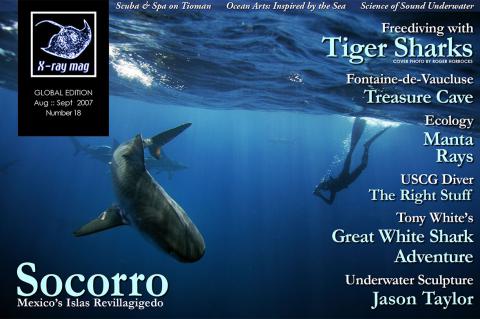Noise
Aquatic animals, like their land-based relatives, can communicate in a number of ways. For example, in one form of communication, organisms can emit and detect certain organic molecules which can function as the pheromones of land based creatures. This is a sexual communication.
Tags & Taxonomy
Electrical fields can also play a part in communication; and most aquatic creatures can also detect movement; this includes both plants and fishes (see Xray-mag.com #10 for the detection of movement by fish). All these forms mostly function over short distances of the order of centimetres, although chemical signals, such as blood can also be detected over relatively large distances, tens of metres, by sharks, for example.
Water, as we have previously seen in this magazine, has many properties that have been utilised by terrestrial organisms. One of them, the ability of water to transmit sound waves, is of great importance for marine organisms enabling them not only to investigate their immediate environments but also to communicate.
Noise
Standing on the seashore one would never know the amazing amount of noise to be found below the surface of even an apparently quiescent sea. Noise is created by the surf and winds, of course, but a large amount is created by humans with their boats such as the big oil tankers. In a minor way, countless divers going about their professions or hobbies also create noise. It is not generally appreciated, though, that fish, whales, and even crustaceans, create an amazing amount of noise underwater.
However, when we speak of noise we must be careful to distinguish between what we generally call noise, which is just what it says, an indiscriminate inharmonious muddle of sound, and a useful sound signal, which can be used for communication.
For those animals living above water, it is the sense of sight and, to a lesser degree, hearing, that functions over great distances. Vision can be unlimited in its reach (we can see to the edge of the universe) while sound can be detected over several thousand kilometres after volcano explosions. And so it is with aquatic creatures, although vision can often be limited to a few metres by conditions in the water. Thus, it is mostly the sense of hearing that functions as a means of long distance communication under the surface of the oceans, whales appearing to be able to communicate using sound over distances of thousands of kilometres.
The aquatic organisms that use sound for communication, in its broadest sense, are the fishes and the aquatic mammals. These, however, emit, detect and use sound in fundamentally different ways. So, this article will only discuss the use of sound by the aquatic mammals leaving other marine creatures to be discussed in a subsequent article. However, before describing these ways, we must first look at what is meant by sound in water.
(...)
Download the full article ⬇︎

Originally published
X-Ray Mag #18
Soccoro Island a.k.a. islas Revillagigedos. Wolfgang dances with Tiger - free diving with Tiger sharks. Manta Ray Ecology. Great White Shark diving - with no cages Science of Sound in water. Diving solo with rebreathers - safely. Mastering Strobe Photography



